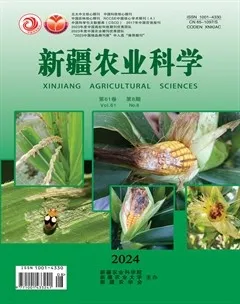不同粒级春小麦种子活力差异比较
2024-12-31刘旭欢于姗刘跃石书兵
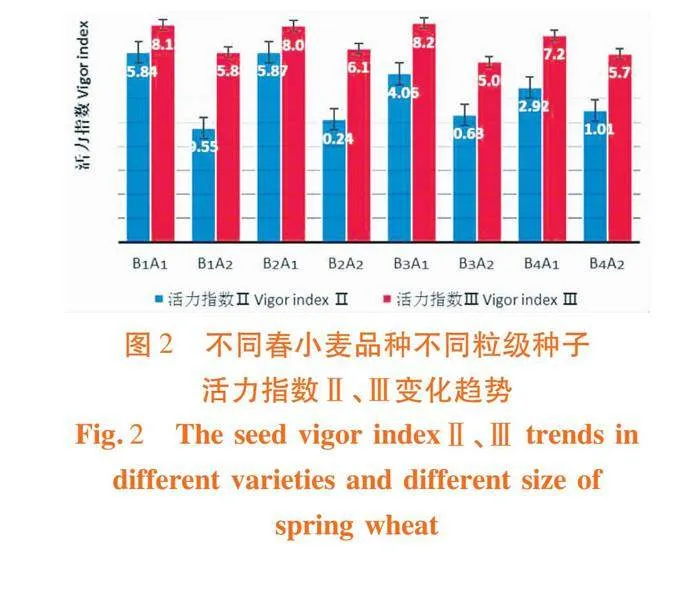
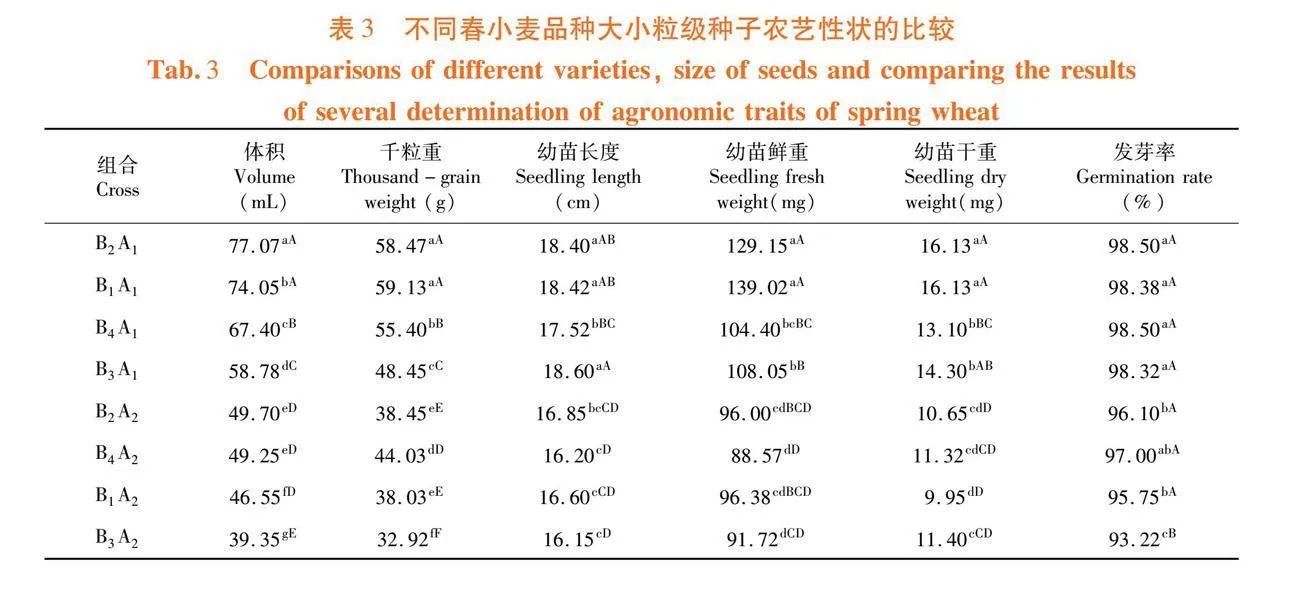
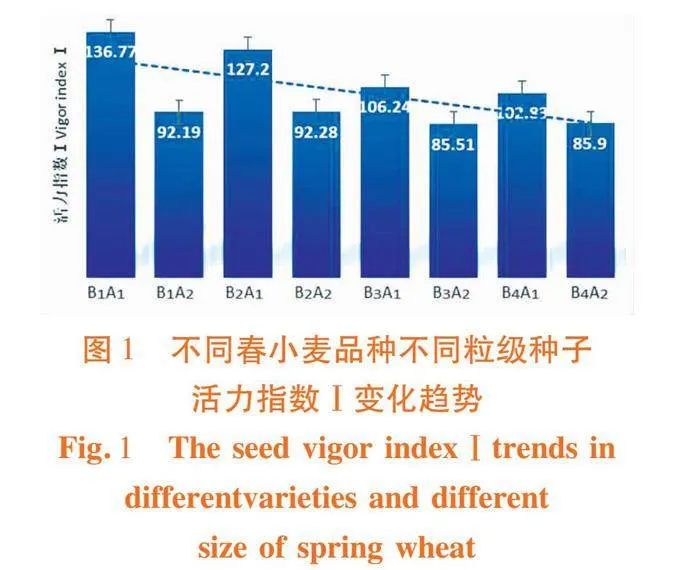
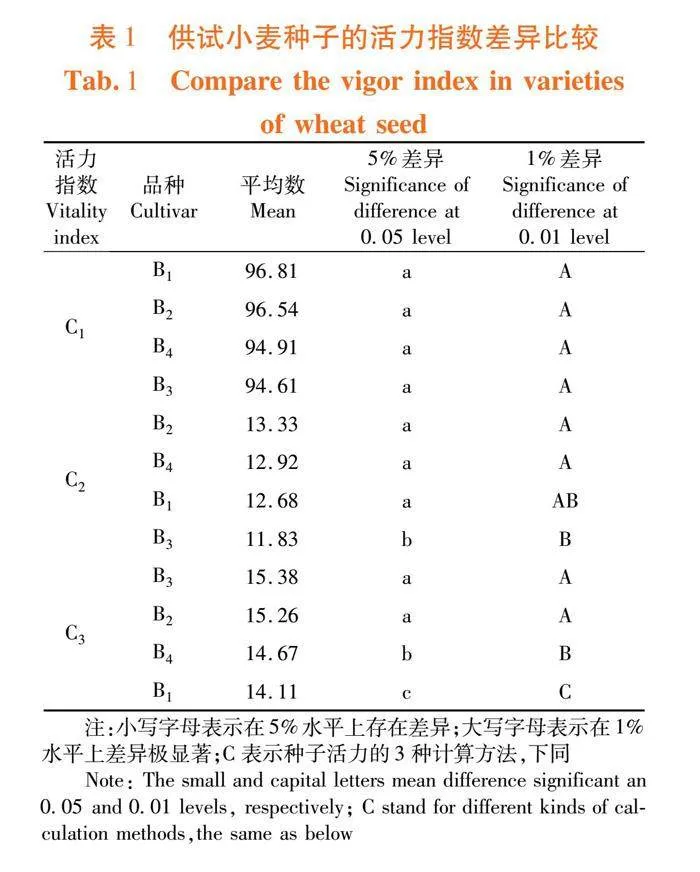
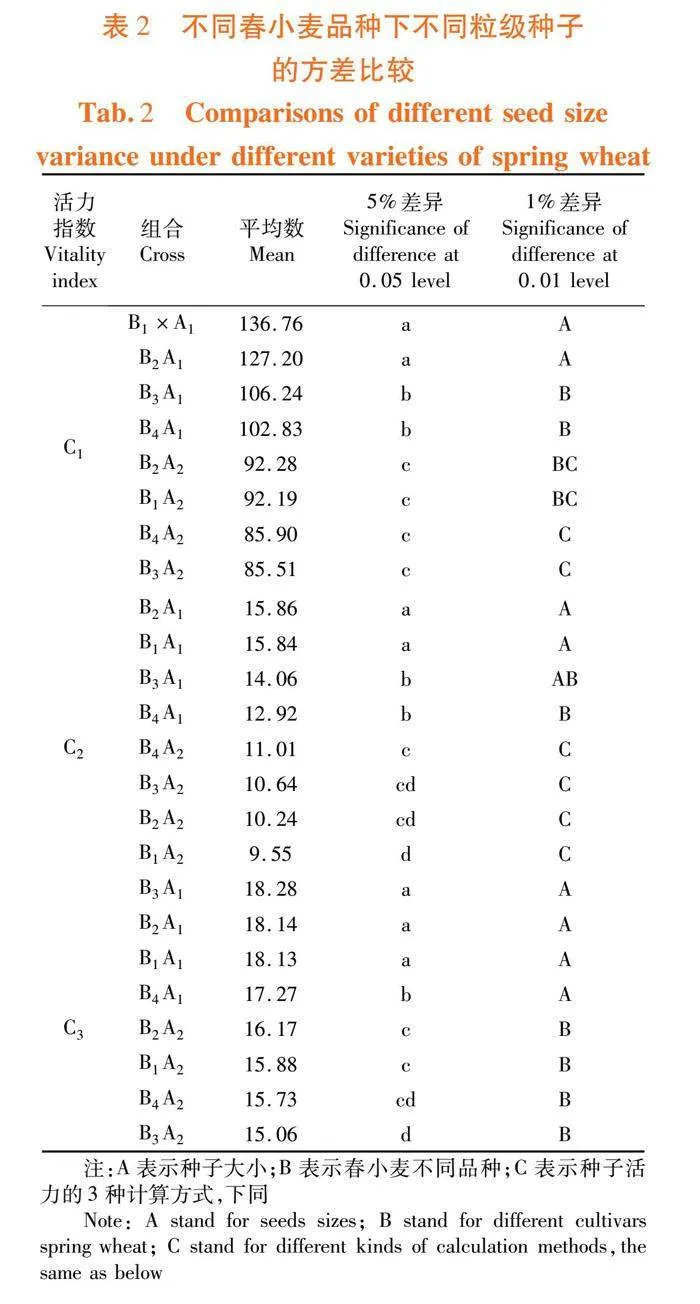
摘 要:【目的】研究不同粒级春小麦品种间、粒级间种子活力的差异。
【方法】采用3种不同的种子活力简易指数计算方法,分析新春29号、新春34号、新春11号、新春30号等4个当季收获品种大粒、小粒2个粒级的种子活力。
【结果】不同品种间种子活力均达到了极显著性差异,相同品种中的大粒种子与小粒种子间呈极显著性差异,但不同品种间的大粒、小粒种子活力大小排序并不一致。
【结论】春小麦不同品种种子活力高低不仅要依据种子活力指数计算方式,还要根据其农艺性状或生理生化特性进行综合判定;同一品种春小麦种子,体积大、千粒重高则表现出较高的活力,不同品种种子体积的大小和千粒重的高低与种子活力高低并无较一致关系,因此不能仅依靠单一的指标判定种子活力的高低。
关键词:春小麦;种子大小;种子活力
中图分类号:S512.1+2 ""文献标志码:A ""文章编号:1001-4330(2024)08-1883-05
收稿日期(Received):2024-02-02
基金项目:新疆维吾尔自治区高校科研计划项目“春小麦高活力种子关键技术研究与示范”(XJEDU20211011)
作者简介:刘旭欢(1988-),女,新疆呼图壁人,硕士研究生,研究方向为作物栽培与耕作,(E-mail)472543919@qq.com
通讯作者:石书兵(1966-),男,山东人,教授,博士,硕士生/博士生导师,研究方向为小麦高产栽培,(E-mail)shbshi@sina.com
0 引 言
【研究意义】种子活力是小麦一播全苗的关键因素,种子籽粒大小影响萌发出苗和幼苗生长发育。关于小麦种子大小对幼苗生长发育和产量的研究显示[1-3],萌发率、苗长、幼苗生长速度[4]等与种子大小有显著相关性,大粒种子的幼苗株高、生物量等均大于或者多于小粒种子形成的幼苗[5-6]。【前人研究进展】Turk[7]、张世挺等[8]研究则发现,种子千粒重与幼苗重量呈显著正相关,与相对生长率则呈负相关性[9]。【本研究切入点】高活力种子的产量明显比低活力种子的产量高,与此同时,种子活力高低受多重因素的限制,究竟以何种计算判断种子活力的大小,目前仍没有较一致的研究结果,例如花生[10]、油菜[11]等均采用一种种子活力计算方法判断种子的活力,采用3种不同的种子活力简易指数计算方法,对比其种子活力差异具有实际意义。【拟解决的关键问题】通过对春小麦品种间、大小间种子活力变化进行逐步试验,探究春小麦种子大小对种子活力的影响,为小麦在高产优质栽培中选择较高活力种子提供理论依据和参考。
1 材料与方法
1.1 材 料
选用2023年新疆农业科学院奇台麦类试验站当季种植并收获的4个不同春小麦参试品种为新春29号(B1)、新春34号(B2)、新春11号(B3)、新春30号(B4)作为供试材料。用圆孔筛将不同品种的春小麦种子分为大粒(A1)和小粒(A2)两级,筛孔孔径分别为3.0~3.5、2.0~2.5 mm。
1.2 方 法
1.2.1 试验设计
按照种子检验规程[12]进行种子室内发芽试验,用蒸馏水冲洗干净已消毒的种子,置于标准发芽盒内,发芽盒底部放有2层含饱和水分的滤纸,将100粒种子放在滤纸上,腹沟向下,种胚朝上。重复4次,将各处理放入20℃光照培养箱中发芽,逐日统计正常发芽的种子数,第4 d开始记录正常发芽种子数,第7 d记录正常发芽种子总数。
1.2.2 测定指标
1.2.2.1 幼苗鲜重
用天平称取每个重复幼苗的重量(mg),计算单株的平均值。
1.2.2.2 幼苗干重
先将待测幼苗放入纸袋中,后在烘箱中杀青,再降温烘干至恒重,冷却后用天平称取重量(mg),计算单株的平均值。
春小麦种子测量指标计算参考石海春等的方法[13]。
发芽率(%)=7 d内正常发芽种子数/供试种子数×100%;活力指数Ⅰ(C1)=发芽率×幼苗鲜重;活力指数Ⅱ(C2)=发芽率×幼苗干重;活力指数Ⅲ(C3)=发芽率×幼苗长度。
1.3 数据处理
所得数据处理采用Excel2021、SPSS18.0进行处理。
2 结果与分析
2.1 不同春小麦品种间种子活力差异比较
研究表明,不同计算方式下的种子活力指数大小顺序不一致,活力指数Ⅰ:B1>B2>B4>B3,活力指数Ⅱ:B2>B4>B1>B3,活力指数Ⅲ:B3>B2>B4>B1。其中,在C1计算方法下进行的方差分析显示,B1、B2、B3、B4间不论在5%水平下还是1%水平下均差异不显著;用C2计算各项差值的绝对值分别为1.19、1.3和0.73,B1、B2、B4与B3均达差异极显著;而用C3计算时,B2与B3间无差异,但两者与B1、B4均达差异极显著,同时B1与B4间达到极显著差异。表1,图1~2
2.2 不同春小麦品种不同粒级种子活力差异比较
研究表明,同一品种种子活力指数变化趋势和种子大小的趋势表现一致,种子活力趋势线整体下滑,因此,在供试样品内,种子的体积、千粒重越大,其种子活力就越高。用C1计算B1、B2、B3和B4大小粒种子活力差值分别为44.58、34.92、20.73和16、93,而用C2、C3计算时,B1、B2、B3和B4大小种子活力差异分别为6.29、2.25;5.62和1.89;3.42、3.23;1.92和1.55,其差值均存在显著或极显著差异,选择体积大、千粒重高的春小麦种子,产量效益较为理想。表2
2.3 不同春小麦品种不同粒级种子农艺性状的差异
研究表明,大粒中体积大小的排序顺序为B2>B1>B4>B3,千粒重的大小顺序B1>B2>B4>B3;C1的大小顺序为B1>B2>B3>B4;C2的大小顺序为B2>B1>B3>B4;C3的大小顺序为B3>B1>B2>B4。
小粒种子中体积大小的排列顺序B2>B4>B1>B3,千粒重的大小排序B4>B2>B1>B3。C1的大小顺序为B2>B1>B4>B3;C2的大小顺序为B4>B3>B2>B1;C3的大小顺序为B2>B1>B4>B3。不同春小麦品种间,不同计算方式下的种子活力与体积大小、千粒重高低关系尚不明确,即不同品种之间运用3种不同的方式计算得出的种子活力指数与各种子粒级大小并无显著相关,小种子的活力并不一定比大种子的活力低。表3
3 讨 论
3.1
植物重要特性之一就是种子体积的大小[14],大粒种子的幼苗在早期通常表现出比小粒种子幼苗大的生长趋势,大粒种子还可能有较强的抗逆性、抗旱能力等 [15、16],但小种子的幼苗只要在适宜的环境下,其幼苗体自身能够经过自我调节的方式消除幼苗早期生长所带来的差异,进而达到与大粒种子类似的生长状况[15]。近些年,在研究种子萌发、产量质量、幼苗质量等对种子大小、重量关系的报道很多,研究结果显示,在不同植物中,发芽等因素对种子大小和质量的影响不尽相同[17]。研究中,相同品种体积大、千粒重高的种子其活力表现出较高的趋势;不同品种间种子体积、千粒重与活力大小并无明显的趋势。主要是由其种子内的初始物质含量决定的[18],由于较大种子产生的幼苗活力旺盛,能更好地应付不同的环境变化和危险事件的发生,如竞争、干旱、遮荫和落叶等[19]。
3.2
种子大小的测定通常包括种子的长度、宽度、厚度和千粒重的测定。种子长度与模拟田间出苗率呈极显著正相关,种子宽度和厚度与模拟田间出苗率呈显著负相关[20],而研究表明,种子活力指数与粒级大小呈显著负相关,说明不同春小麦籽粒大小与种子活力之间的相关性无明显规律。幼苗生长测定的发芽率、幼苗鲜重、幼苗干重、幼苗长度等指标,一直被认为是比较可靠的活力指标[21]。研究上述指标与种子活力存在显著或极显著相关性,幼苗生长测定是小麦种子活力测定的较好方法,与顾增辉等[22]的研究结果一致。
3.3
表示种子活力高低的指标很多,主要有发芽率、幼苗鲜重(干重)、活力指数等[23]。研究在比较不同品种的春小麦种子活力高低时发现,种子活力高低不仅取决于种子活力指数计算方式,同时也受品种农艺性状、生理生化特性等影响。试验研究表明4种春小麦种子的千粒重、体积与种子大小均有正相关关系,在对不同品种处理下的苗长,幼苗鲜重、干重等测量结果分析发现,不同品种及种子粒级间均存在显著性差异,此结果与前人研究相似[24-25]。
4 结 论
4.1 在3种不同的活力指数计算方式下,新春29号均呈较优趋势,而其他3个品种的各项指标均未呈较一致的趋势性。
4.2 比较春小麦不同品种的种子活力高低不仅要依据所采用的种子活力指数计算方式,而且要根据其农艺性状或生理生化特性进行综合判定;同一品种春小麦种子,体积大、千粒重高则表现出较高的活力,不同品种种子体积的大小和千粒重的高低与种子活力高低并无明显的关系。
4.3 种子活力是一个较复杂的生理指标,仅用单一的方法进行测定其结果可能有一定规律性,而用不同的测定方法,其结果将存在差异。
参考文献(References)
[1] Gan Y T, Stobbe E H, Moes J. Relative date of wheat seedling emergence and its impact on grain yield[J]. Crop Science, 1992, 32(5): 1275-1281.
[2] Rao SKInfluence of seed size on field germination, seedling vigor, yield and quantity of self-pollinated crop: A review [J]. Agricultural Review,1981, 2:95-101.
[3] Benjamin L R. Variation in time of seedling emergence within populations: a feature that determines individual growth and development[M]//Advances in Agronomy Volume 44. Amsterdam: Elsevier, 1990: 1-25.
[4] Koger C H, Reddy K N, Poston D H. Factors affecting seed germination, seedling emergence, and survival of texasweed (Caperonia palustris)[J]. Weed Science, 2004, 52(6): 989-995.
[5] 柯文山, 钟章成, 席红安, 等. 四川大头茶地理种群种子大小变异及对萌发、幼苗特征的影响[J]. 生态学报, 2000, 20(4): 697-701.
KE Wenshan, ZHONG Zhangcheng, XI Hongan, et al. The variation of seed sizes of Gordonia acuminata geographic populations and its effect on seed germination and seedling[J]. Acta Ecologica Sinica, 2000, 20(4): 697-701.
[6] Liu W D, Cui J M, Wang H C. Effects of seed size on winter wheat seedling and its young-spike development[J]. Seed, 2004, 23(3):33-35.
[7] Turk M A, Taw A R M, Lee K D. Seed germination and seedling growth of three lentil cultivars under moisture stress[J]. Asian Journal of Plant Sciences, 2004, 3(3): 394-397.
[8] 张世挺, 杜国祯, 陈家宽, 等. 不同营养条件下24种高寒草甸菊科植物种子重量对幼苗生长的影响[J]. 生态学报, 2003, 23(9): 1737-1744.
ZHANG Shiting, DU Guozhen, CHEN Jiakuan, et al. Effects of seed weight on seedling growth under different nutrient conditions in twenty-four species of Compositae in an Alpine Meadow[J]. Acta Ecologica Sinica, 2003, 23(9): 1737-1744.
[9] Swanborough P, Westoby M. Seedling relative growth rate and its components in relation to seed size: phylogenetically independent contrasts[J]. Functional Ecology, 1996, 10(2): 176.
[10] 郭陞垚, 陈剑洪, 王金线, 等. 花生种子大小对产量及品质的影响[J]. 福建农业学报, 2012, 27(7): 700-706.
GUO Shengyao, CHEN Jianhong, WANG Jinxian, et al. Effects of seed size on yield and quality of peanuts[J]. Fujian Journal of Agricultural Sciences, 2012, 27(7): 700-706.
[11] 李孟良. 油菜不同部位粒重差异及种子活力研究[J]. 中国农学通报, 2007, 23(6): 284-287.
LI Mengliang. Study on the difference of grain weight and seed vigor among the different parts of the rape[J]. Chinese Agricultural Science Bulletin, 2007, 23(6): 284-287.
[12] 石海春, 柯永培, 刘帆, 等. 不同大小的玉米种子活力差异比较研究[J]. 种子, 2005, 24(4): 37-39.
SHI Haichun, KE Yongpei, LIU Fan, et al. Comparative study on the difference of vigor of maize seeds with different sizes[J]. Seed, 2005, 24(4): 37-39.
[13] Shao M. Study on the seed weight and seed seize variation pattern and their biological sinificance in Podophylloideae (Berberidaceae) [J]. Seed, 1999.
[14] Qin D H. The external morphology and seed vigor [J].Seed,1989,1:7-9.
[15] Zhao S J,Shi G A,Dong X C. Plant physiology experiment instruction [M].Beijing: China Agricultural Science and Technology Press,2002,47-55.
[16] Tang R H,Fu Q Z. The influence of germination potential, germination rate and seedling quality on melon seed size [J].Seed,1997,6:57-58.
[17] Green P T, Juniper P A. Seed–seedling allometry in tropical rain forest trees: seed mass-related patterns of resource allocation and the ‘reserve effect’[J]. Journal of Ecology, 2004, 92(3): 397-408.
[18] Westby M, Leishman M, Lord J.Comparative ecology of seed size and dispersal. Philosophical Transactions of the Royal Society of London (B), 1996, 351:1309-1318.
[19] Zhang B H,Hao X,Li Y K,etal. The seed vigor and its measuring method [J]. Agricultural Mechanization Research,2006,6:86-87.
[20] Gu Z H,Xu B M,Zheng G H. Determination method of seed vigor of germination physiological measurement (Ⅱ) [J].Seed,1982,3:12-17.
[21] 高伟娜, 顾小清, 乔晓岚, 等. 高压静电场对老化水稻种子活力的影响[J]. 西北农业学报, 2007, 16(2): 37-40.
GAO Weina, GU Xiaoqing, QIAO Xiaolan, et al. Effect of HVEF on the seed vigor of aging rice seeds[J]. Acta Agriculturae Boreali-Occidentalis Sinica, 2007, 16(2): 37-40.
[22] Wu G L, Du G Z. Relationships between seed size and seedling growth strategy of herbaceous plant: a review[J]. Ying Yong Sheng Tai Xue Bao = the Journal of Applied Ecology, 2008, 19(1): 191-197.
[23] Jakobsson A, Eriksson O. A comparative study of seed number, seed size, seedling size and recruitment in grassland plants[J]. Oikos, 2000, 88(3): 494-502.
[24] Wu G, Chen M, Zhou X, et al. Response of morphological plasticity of three herbaceous seedlings to light and nutrition in the qing-Hai Tibetan Plateau[J]. Asian Journal of Plant Sciences, 2006, 5(4): 635-642.
[25] Vaughton G, Ramsey M. Sources and consequences of seed mass variation in Banksia marginata (Proteaceae)[J]. Journal of Ecology, 1998, 86(4): 563-573.
Comparative on the vigor differences of spring wheat
seeds of different sizes
LIU Xuhuan1, YU Shan2, LIU Yue2, SHI Shubing2
(1. Association of Science and Technology of Xinjiang Uygur Autonomous Region, Urumqi 830052, China;2.Graduate School, Xinjiang Agricultural University, Urumqi 830052, China)
Abstract:【Objective】 Study on the differences in seed vitality between different grain sizes of spring wheat varieties and grainsizes.
【Methods】 The purpose of the study is to determine the differ by using 3 kinds of calculation methods on varieties and sizes spring wheat.
【Results】 The results showed that when using different calculation methods for the calculation of different varieties of seed vigor, the results were very significantly different; The ranking of seed vigor size was also inconsistent between different varieties; In addition, when the calculation methods were used to calculate the seed vigor, differences were shown between large seeds and small ones in different varieties. Therefore, the comparison of seed vigor of different spring wheat varieties should not be only based on the calculation method of seed vigor index, but also according to the comprehensive agronomic characters and physiological and biochemical characteristics to make the judgment.
【Conclusion】 Spring wheat seeds of the same variety which have large size and high 1000 grain weight show high vigor. There is no obvious relationship between the seed size and 1000 seed weight of different varieties and the seed vigor, so the seed vigor cannot be determined by a single index. The same varieties, large size or high grain spring wheat seeds, its energy is higher, different varieties, the size of the volume and level of high and low and seed vigor and has no obvious relation, so we can't just rely on a single index to determining the seed vigor
Key words:spring wheat; seed sizes; seed vigor
Fund projects:The University R amp; D Program Project of Xinjiang Uygur Autonomous Region “Research and Demonstration of the Key Technology of High-Vigor Seed in Spring Wheat(XJEDU20211011)
Correspondence author:SHI Shubing(1966-),male,from Shandong, professor,Doctoral supervisor,research direction: the research of high-yield cultivation of wheat, (E-mail)shbshi@sina.com
